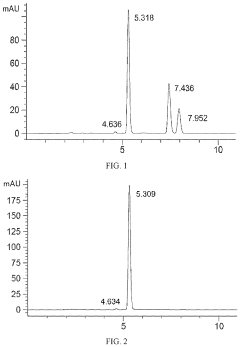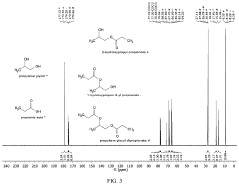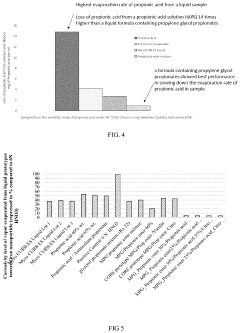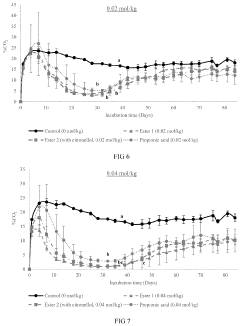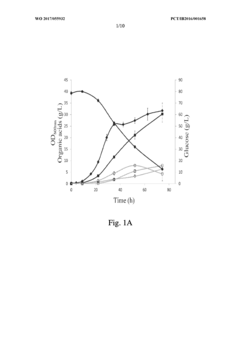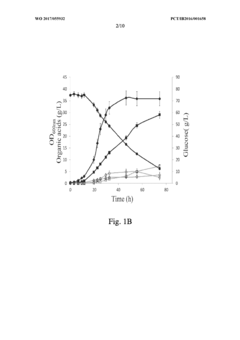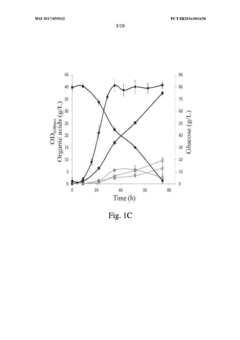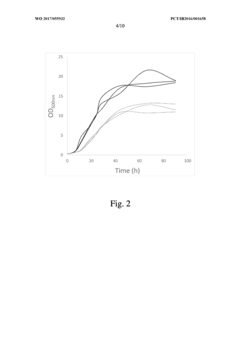Propionic Acid and Its Function in Food Security Measures
JUL 3, 20259 MIN READ
Generate Your Research Report Instantly with AI Agent
Patsnap Eureka helps you evaluate technical feasibility & market potential.
Propionic Acid Background and Objectives
Propionic acid, a naturally occurring carboxylic acid, has been a subject of significant interest in the food industry for decades. Its history in food preservation dates back to the early 20th century when researchers first identified its antimicrobial properties. Since then, propionic acid and its salts have become integral components in food security measures, playing a crucial role in extending the shelf life of various food products.
The evolution of propionic acid usage in food preservation has been driven by the increasing demand for safe, long-lasting food products in a globalized market. As food supply chains have become more complex and extended, the need for effective preservatives has grown exponentially. Propionic acid has emerged as a key player in this landscape, offering a balance between efficacy and consumer acceptability.
In recent years, the focus on propionic acid research has shifted towards understanding its mechanisms of action at a molecular level. This deeper comprehension has led to more targeted and efficient applications in food preservation. Simultaneously, there has been a growing interest in exploring the potential synergistic effects of propionic acid with other preservatives, aiming to create more robust food security systems.
The objectives of current research on propionic acid in food security measures are multifaceted. Primarily, there is a drive to enhance its effectiveness against a broader spectrum of microorganisms, particularly in light of emerging food-borne pathogens. Researchers are also investigating ways to minimize the sensory impact of propionic acid on food products, addressing consumer preferences for "clean label" foods.
Another key objective is to develop novel delivery systems for propionic acid, which could improve its distribution and retention in food matrices. This includes exploring microencapsulation techniques and smart packaging solutions that can release propionic acid in a controlled manner, optimizing its preservative effects.
Furthermore, there is an increasing emphasis on understanding the environmental impact of propionic acid production and use. Researchers are exploring more sustainable production methods, including bio-based approaches, to align with global sustainability goals. This aspect of research is particularly crucial as the food industry faces mounting pressure to reduce its environmental footprint.
As we look to the future, the research on propionic acid is expected to continue evolving, with a focus on addressing emerging challenges in food security. This includes adapting to changing consumer preferences, meeting stricter regulatory requirements, and combating new microbial threats. The ultimate goal remains to ensure food safety and quality while meeting the demands of a growing global population.
The evolution of propionic acid usage in food preservation has been driven by the increasing demand for safe, long-lasting food products in a globalized market. As food supply chains have become more complex and extended, the need for effective preservatives has grown exponentially. Propionic acid has emerged as a key player in this landscape, offering a balance between efficacy and consumer acceptability.
In recent years, the focus on propionic acid research has shifted towards understanding its mechanisms of action at a molecular level. This deeper comprehension has led to more targeted and efficient applications in food preservation. Simultaneously, there has been a growing interest in exploring the potential synergistic effects of propionic acid with other preservatives, aiming to create more robust food security systems.
The objectives of current research on propionic acid in food security measures are multifaceted. Primarily, there is a drive to enhance its effectiveness against a broader spectrum of microorganisms, particularly in light of emerging food-borne pathogens. Researchers are also investigating ways to minimize the sensory impact of propionic acid on food products, addressing consumer preferences for "clean label" foods.
Another key objective is to develop novel delivery systems for propionic acid, which could improve its distribution and retention in food matrices. This includes exploring microencapsulation techniques and smart packaging solutions that can release propionic acid in a controlled manner, optimizing its preservative effects.
Furthermore, there is an increasing emphasis on understanding the environmental impact of propionic acid production and use. Researchers are exploring more sustainable production methods, including bio-based approaches, to align with global sustainability goals. This aspect of research is particularly crucial as the food industry faces mounting pressure to reduce its environmental footprint.
As we look to the future, the research on propionic acid is expected to continue evolving, with a focus on addressing emerging challenges in food security. This includes adapting to changing consumer preferences, meeting stricter regulatory requirements, and combating new microbial threats. The ultimate goal remains to ensure food safety and quality while meeting the demands of a growing global population.
Market Analysis for Food Preservatives
The food preservatives market has been experiencing significant growth due to increasing consumer demand for processed and convenience foods with extended shelf life. Propionic acid, as a key food preservative, plays a crucial role in this expanding market. The global food preservatives market was valued at approximately $2.5 billion in 2020 and is projected to reach $3.2 billion by 2025, growing at a CAGR of around 4.5% during the forecast period.
Propionic acid and its salts, particularly calcium propionate and sodium propionate, are widely used in the bakery industry to prevent mold growth and extend the shelf life of bread and other baked goods. This segment accounts for a substantial portion of the food preservatives market, driven by the rising consumption of bakery products worldwide.
The increasing awareness of food safety and the need for longer shelf life in developing countries are major factors contributing to the growth of the propionic acid market in food preservation. As urbanization and changing lifestyles lead to higher consumption of packaged and processed foods, the demand for effective preservatives like propionic acid continues to rise.
In terms of regional analysis, North America and Europe currently dominate the food preservatives market, including propionic acid-based preservatives. However, the Asia-Pacific region is expected to witness the highest growth rate in the coming years due to rapid industrialization, increasing disposable income, and changing dietary habits.
The market for natural and clean-label preservatives is also gaining traction, presenting both challenges and opportunities for propionic acid manufacturers. While propionic acid is considered a synthetic preservative, its natural occurrence in some foods and its effectiveness at low concentrations make it a relatively favorable option compared to other synthetic preservatives.
Key players in the propionic acid market for food preservation include BASF SE, Dow Inc., Eastman Chemical Company, and Perstorp Holding AB. These companies are focusing on research and development to improve the efficacy and application range of propionic acid-based preservatives, as well as exploring more sustainable production methods to meet the growing market demand.
The regulatory landscape also plays a significant role in shaping the market for propionic acid as a food preservative. While it is generally recognized as safe (GRAS) by the FDA and approved for use in many countries, ongoing research into its long-term effects and potential alternatives may influence future market dynamics.
Propionic acid and its salts, particularly calcium propionate and sodium propionate, are widely used in the bakery industry to prevent mold growth and extend the shelf life of bread and other baked goods. This segment accounts for a substantial portion of the food preservatives market, driven by the rising consumption of bakery products worldwide.
The increasing awareness of food safety and the need for longer shelf life in developing countries are major factors contributing to the growth of the propionic acid market in food preservation. As urbanization and changing lifestyles lead to higher consumption of packaged and processed foods, the demand for effective preservatives like propionic acid continues to rise.
In terms of regional analysis, North America and Europe currently dominate the food preservatives market, including propionic acid-based preservatives. However, the Asia-Pacific region is expected to witness the highest growth rate in the coming years due to rapid industrialization, increasing disposable income, and changing dietary habits.
The market for natural and clean-label preservatives is also gaining traction, presenting both challenges and opportunities for propionic acid manufacturers. While propionic acid is considered a synthetic preservative, its natural occurrence in some foods and its effectiveness at low concentrations make it a relatively favorable option compared to other synthetic preservatives.
Key players in the propionic acid market for food preservation include BASF SE, Dow Inc., Eastman Chemical Company, and Perstorp Holding AB. These companies are focusing on research and development to improve the efficacy and application range of propionic acid-based preservatives, as well as exploring more sustainable production methods to meet the growing market demand.
The regulatory landscape also plays a significant role in shaping the market for propionic acid as a food preservative. While it is generally recognized as safe (GRAS) by the FDA and approved for use in many countries, ongoing research into its long-term effects and potential alternatives may influence future market dynamics.
Current Challenges in Food Preservation
Food preservation remains a critical challenge in ensuring global food security and reducing food waste. Despite significant advancements in preservation techniques, several obstacles persist in maintaining food quality and safety over extended periods.
One of the primary challenges is the development of effective and safe preservatives that can inhibit microbial growth without compromising food quality or posing health risks to consumers. Traditional chemical preservatives often face scrutiny due to potential adverse health effects and consumer demand for "clean label" products. This has led to a growing interest in natural preservatives, such as propionic acid, which is found naturally in some foods and has demonstrated antimicrobial properties.
The emergence of antibiotic-resistant microorganisms presents another significant challenge in food preservation. As bacteria evolve and adapt to existing preservation methods, there is an urgent need for innovative approaches to combat these resistant strains. This necessitates ongoing research into novel preservation techniques and the exploration of synergistic combinations of preservatives to enhance their efficacy.
Temperature control during storage and transportation remains a persistent issue, particularly in developing countries with limited cold chain infrastructure. Fluctuations in temperature can accelerate microbial growth and chemical reactions that lead to food spoilage. Developing cost-effective and energy-efficient cooling solutions for the entire food supply chain is crucial to address this challenge.
The increasing consumer demand for minimally processed foods with extended shelf life poses a significant technical challenge. Balancing the preservation of nutritional value, sensory qualities, and food safety while minimizing processing interventions requires sophisticated preservation strategies. This has led to growing interest in non-thermal preservation technologies, such as high-pressure processing and pulsed electric fields.
Packaging innovations play a vital role in food preservation, but challenges remain in developing sustainable, biodegradable packaging materials that maintain the same level of protection as traditional plastics. Additionally, the integration of smart packaging technologies for real-time monitoring of food quality and safety is an area of active research and development.
Lastly, the globalization of food trade has introduced new challenges in preserving food quality and safety across long-distance transportation and varying environmental conditions. This requires the development of preservation methods that are robust enough to withstand diverse storage and transportation scenarios while complying with international food safety regulations.
One of the primary challenges is the development of effective and safe preservatives that can inhibit microbial growth without compromising food quality or posing health risks to consumers. Traditional chemical preservatives often face scrutiny due to potential adverse health effects and consumer demand for "clean label" products. This has led to a growing interest in natural preservatives, such as propionic acid, which is found naturally in some foods and has demonstrated antimicrobial properties.
The emergence of antibiotic-resistant microorganisms presents another significant challenge in food preservation. As bacteria evolve and adapt to existing preservation methods, there is an urgent need for innovative approaches to combat these resistant strains. This necessitates ongoing research into novel preservation techniques and the exploration of synergistic combinations of preservatives to enhance their efficacy.
Temperature control during storage and transportation remains a persistent issue, particularly in developing countries with limited cold chain infrastructure. Fluctuations in temperature can accelerate microbial growth and chemical reactions that lead to food spoilage. Developing cost-effective and energy-efficient cooling solutions for the entire food supply chain is crucial to address this challenge.
The increasing consumer demand for minimally processed foods with extended shelf life poses a significant technical challenge. Balancing the preservation of nutritional value, sensory qualities, and food safety while minimizing processing interventions requires sophisticated preservation strategies. This has led to growing interest in non-thermal preservation technologies, such as high-pressure processing and pulsed electric fields.
Packaging innovations play a vital role in food preservation, but challenges remain in developing sustainable, biodegradable packaging materials that maintain the same level of protection as traditional plastics. Additionally, the integration of smart packaging technologies for real-time monitoring of food quality and safety is an area of active research and development.
Lastly, the globalization of food trade has introduced new challenges in preserving food quality and safety across long-distance transportation and varying environmental conditions. This requires the development of preservation methods that are robust enough to withstand diverse storage and transportation scenarios while complying with international food safety regulations.
Existing Propionic Acid Applications
01 Production methods of propionic acid
Various methods for producing propionic acid are described, including fermentation processes, chemical synthesis routes, and catalytic reactions. These methods aim to improve yield, efficiency, and purity of propionic acid production for industrial applications.- Production methods of propionic acid: Various methods are employed for the production of propionic acid, including fermentation processes, chemical synthesis, and catalytic reactions. These methods often involve the use of specific microorganisms, catalysts, or chemical precursors to efficiently produce propionic acid on an industrial scale.
- Applications of propionic acid in food preservation: Propionic acid and its salts are widely used as food preservatives due to their antimicrobial properties. They are effective in preventing mold growth and extending the shelf life of various food products, particularly in baked goods, dairy products, and animal feed.
- Use of propionic acid in pharmaceutical and cosmetic industries: Propionic acid finds applications in the pharmaceutical and cosmetic industries. It is used as a precursor in the synthesis of certain drugs and as a pH adjuster in various formulations. In cosmetics, it may be used as a preservative or in the production of other cosmetic ingredients.
- Environmental and industrial applications of propionic acid: Propionic acid has various environmental and industrial applications. It is used in the production of cellulose acetate propionate, a biodegradable plastic. Additionally, it finds use in herbicides, solvents, and as a chemical intermediate in the production of other compounds.
- Purification and recovery methods for propionic acid: Various techniques are employed for the purification and recovery of propionic acid from reaction mixtures or fermentation broths. These methods may include distillation, extraction, crystallization, or membrane-based separation processes to obtain high-purity propionic acid for commercial use.
02 Applications of propionic acid in food preservation
Propionic acid and its salts are widely used as food preservatives due to their antimicrobial properties. They are effective against molds and some bacteria, extending the shelf life of various food products, particularly in bakery goods and dairy products.Expand Specific Solutions03 Use of propionic acid in pharmaceutical formulations
Propionic acid and its derivatives find applications in pharmaceutical formulations. They are used as excipients, pH adjusters, and in some cases as active pharmaceutical ingredients for various therapeutic purposes.Expand Specific Solutions04 Propionic acid in polymer and plastics industry
Propionic acid serves as a precursor or additive in the production of various polymers and plastics. It is used in the synthesis of cellulose-based plastics, as a plasticizer, and in the production of other chemical intermediates for the plastics industry.Expand Specific Solutions05 Environmental and safety considerations in propionic acid handling
The handling, storage, and disposal of propionic acid require specific safety measures due to its corrosive nature and potential environmental impact. Innovations in this area focus on developing safer handling methods, reducing environmental risks, and improving workplace safety in industries using propionic acid.Expand Specific Solutions
Key Players in Food Preservative Industry
The research on propionic acid and its function in food security measures is in a developing stage, with growing market potential due to increasing concerns about food safety and preservation. The global market for propionic acid in food applications is expanding, driven by its effectiveness as a natural preservative. Technologically, the field is advancing, with companies like Kemin Industries and DSM IP Assets BV leading innovation. Academic institutions such as Jiangnan University and Zhejiang University are contributing to fundamental research. The industry is seeing a blend of established players and emerging startups, indicating a competitive landscape with opportunities for technological breakthroughs and market expansion.
Kemin Industries, Inc.
Technical Solution: Kemin Industries has developed a range of propionic acid-based solutions for food preservation, focusing on natural and clean label alternatives. Their research has led to the creation of proprietary blends that combine propionic acid with other natural preservatives, enhancing antimicrobial efficacy while meeting consumer demands for cleaner labels[1]. Kemin has also invested in studying the synergistic effects of propionic acid with antioxidants, developing formulations that not only prevent microbial growth but also retard oxidative rancidity in food products[2]. Additionally, their research extends to the application of propionic acid in animal feed preservation, where they have developed specialized formulations to maintain feed quality and safety[3].
Strengths: Focus on natural and clean label solutions, synergistic formulations with antioxidants, and expertise in both food and feed applications. Weaknesses: Potential challenges in achieving the same level of efficacy as synthetic preservatives and higher costs associated with natural ingredient sourcing.
DSM IP Assets BV
Technical Solution: DSM has developed advanced fermentation technologies for the production of propionic acid, focusing on improving yield and purity. Their approach involves using genetically engineered microorganisms to enhance the fermentation process, resulting in higher production efficiency and reduced costs[1]. DSM's research also extends to the application of propionic acid in food preservation, where they have formulated proprietary blends that synergistically combine propionic acid with other preservatives to extend shelf life and maintain food quality[2]. Additionally, DSM has invested in developing encapsulation technologies to improve the stability and controlled release of propionic acid in various food matrices, enhancing its effectiveness as a preservative[3].
Strengths: Advanced fermentation technology, synergistic preservative blends, and encapsulation techniques. Weaknesses: Potential regulatory challenges with genetically engineered processes and higher production costs compared to traditional methods.
Innovations in Propionic Acid Research
Compositions containing organic acids and their esters to prevent mold contamination in animal feed
PatentPendingUS20230189803A1
Innovation
- Development of carboxylic acid esters of monopropylene glycol with short-chain fatty acids, combined with propionic esters and salts, to create a composition that inhibits mold growth effectively while reducing volatility and corrosiveness, and improving odor, thereby providing long-term protection and enhanced storage properties.
Improved propionibacterium strains for the production of propionic acid
PatentWO2017055932A2
Innovation
- Genome shuffling between selected Propionibacterium strains, such as P. acidipropionici ATCC 4875 and P. acidipropionici ATCC 55737, to generate novel strains with enhanced growth rates and propionic acid production, utilizing genetic material exchange to create strains with improved metabolic pathways and regulatory mechanisms.
Regulatory Framework for Food Additives
The regulatory framework for food additives plays a crucial role in ensuring the safe use of propionic acid in food security measures. Globally, various regulatory bodies have established guidelines and standards for the use of food additives, including propionic acid, to maintain food safety and quality.
In the United States, the Food and Drug Administration (FDA) regulates the use of propionic acid as a food additive. It is classified as Generally Recognized as Safe (GRAS) for its intended use as a preservative in certain food products. The FDA has set specific limits on the concentration of propionic acid that can be used in different food categories, ensuring its safe application in food preservation.
The European Union (EU) has its own regulatory framework for food additives, governed by the European Food Safety Authority (EFSA). Propionic acid is approved for use as a food preservative under the E-number E280. The EU has established maximum permitted levels for propionic acid in various food products, taking into account factors such as dietary intake and potential health effects.
In Canada, Health Canada oversees the regulation of food additives, including propionic acid. The agency has approved its use as a preservative in specific food products, subject to prescribed maximum levels. Similarly, the Food Standards Australia New Zealand (FSANZ) regulates the use of propionic acid in food products within Australia and New Zealand.
International organizations also play a significant role in shaping the regulatory framework for food additives. The Joint FAO/WHO Expert Committee on Food Additives (JECFA) provides scientific evaluations of food additives, including propionic acid, which inform global regulatory decisions. The Codex Alimentarius Commission, established by the FAO and WHO, develops international food standards, guidelines, and codes of practice to ensure food safety and fair trade practices.
These regulatory frameworks typically require manufacturers to demonstrate the safety and efficacy of propionic acid as a food additive. This often involves submitting scientific data on toxicology, metabolism, and intended use levels. Regulatory bodies also consider factors such as technological need, consumer safety, and potential for misuse when evaluating the use of propionic acid in food products.
Ongoing research and monitoring of propionic acid's use in food security measures continue to inform and shape regulatory decisions. As new scientific evidence emerges, regulatory bodies may update their guidelines and standards to ensure the continued safe use of propionic acid in food preservation and security applications.
In the United States, the Food and Drug Administration (FDA) regulates the use of propionic acid as a food additive. It is classified as Generally Recognized as Safe (GRAS) for its intended use as a preservative in certain food products. The FDA has set specific limits on the concentration of propionic acid that can be used in different food categories, ensuring its safe application in food preservation.
The European Union (EU) has its own regulatory framework for food additives, governed by the European Food Safety Authority (EFSA). Propionic acid is approved for use as a food preservative under the E-number E280. The EU has established maximum permitted levels for propionic acid in various food products, taking into account factors such as dietary intake and potential health effects.
In Canada, Health Canada oversees the regulation of food additives, including propionic acid. The agency has approved its use as a preservative in specific food products, subject to prescribed maximum levels. Similarly, the Food Standards Australia New Zealand (FSANZ) regulates the use of propionic acid in food products within Australia and New Zealand.
International organizations also play a significant role in shaping the regulatory framework for food additives. The Joint FAO/WHO Expert Committee on Food Additives (JECFA) provides scientific evaluations of food additives, including propionic acid, which inform global regulatory decisions. The Codex Alimentarius Commission, established by the FAO and WHO, develops international food standards, guidelines, and codes of practice to ensure food safety and fair trade practices.
These regulatory frameworks typically require manufacturers to demonstrate the safety and efficacy of propionic acid as a food additive. This often involves submitting scientific data on toxicology, metabolism, and intended use levels. Regulatory bodies also consider factors such as technological need, consumer safety, and potential for misuse when evaluating the use of propionic acid in food products.
Ongoing research and monitoring of propionic acid's use in food security measures continue to inform and shape regulatory decisions. As new scientific evidence emerges, regulatory bodies may update their guidelines and standards to ensure the continued safe use of propionic acid in food preservation and security applications.
Environmental Impact of Propionic Acid
Propionic acid, while beneficial in food preservation, has potential environmental impacts that warrant careful consideration. The production and use of propionic acid can contribute to various environmental concerns, including air and water pollution, greenhouse gas emissions, and resource depletion.
The manufacturing process of propionic acid often involves petrochemical feedstocks, which are derived from non-renewable fossil fuels. This reliance on fossil resources contributes to the depletion of finite energy sources and increases the carbon footprint associated with propionic acid production. Additionally, the industrial synthesis of propionic acid may generate byproducts and waste streams that require proper treatment and disposal to prevent environmental contamination.
When used in food preservation, propionic acid can enter the environment through various pathways. Residual amounts may be present in food waste or agricultural runoff, potentially affecting aquatic ecosystems. While propionic acid is biodegradable and does not persist in the environment for extended periods, high concentrations in water bodies can temporarily disrupt local ecosystems and impact aquatic organisms.
The transportation and storage of propionic acid also present environmental risks. Accidental spills or leaks during handling and distribution can lead to soil and water contamination. Proper containment measures and emergency response protocols are essential to mitigate these risks and minimize environmental damage.
From a lifecycle perspective, the environmental impact of propionic acid extends beyond its production and use. The disposal of products containing propionic acid, such as treated animal feed or preserved food items, must be managed carefully to prevent the release of harmful substances into the environment. Proper waste management practices and recycling initiatives can help reduce the overall environmental footprint of propionic acid-containing products.
It is important to note that the environmental impact of propionic acid should be balanced against its benefits in food security. By extending the shelf life of food products and reducing food waste, propionic acid indirectly contributes to resource conservation and reduced environmental pressure from food production. However, ongoing research and development efforts are focused on finding more sustainable production methods and alternative preservatives to further minimize the environmental impact of food preservation techniques.
As the food industry continues to prioritize sustainability, there is a growing emphasis on developing bio-based production methods for propionic acid. These approaches, which utilize renewable feedstocks and fermentation processes, have the potential to significantly reduce the environmental footprint of propionic acid production. Additionally, advancements in green chemistry and process optimization are driving improvements in the efficiency and sustainability of propionic acid manufacturing, further mitigating its environmental impact.
The manufacturing process of propionic acid often involves petrochemical feedstocks, which are derived from non-renewable fossil fuels. This reliance on fossil resources contributes to the depletion of finite energy sources and increases the carbon footprint associated with propionic acid production. Additionally, the industrial synthesis of propionic acid may generate byproducts and waste streams that require proper treatment and disposal to prevent environmental contamination.
When used in food preservation, propionic acid can enter the environment through various pathways. Residual amounts may be present in food waste or agricultural runoff, potentially affecting aquatic ecosystems. While propionic acid is biodegradable and does not persist in the environment for extended periods, high concentrations in water bodies can temporarily disrupt local ecosystems and impact aquatic organisms.
The transportation and storage of propionic acid also present environmental risks. Accidental spills or leaks during handling and distribution can lead to soil and water contamination. Proper containment measures and emergency response protocols are essential to mitigate these risks and minimize environmental damage.
From a lifecycle perspective, the environmental impact of propionic acid extends beyond its production and use. The disposal of products containing propionic acid, such as treated animal feed or preserved food items, must be managed carefully to prevent the release of harmful substances into the environment. Proper waste management practices and recycling initiatives can help reduce the overall environmental footprint of propionic acid-containing products.
It is important to note that the environmental impact of propionic acid should be balanced against its benefits in food security. By extending the shelf life of food products and reducing food waste, propionic acid indirectly contributes to resource conservation and reduced environmental pressure from food production. However, ongoing research and development efforts are focused on finding more sustainable production methods and alternative preservatives to further minimize the environmental impact of food preservation techniques.
As the food industry continues to prioritize sustainability, there is a growing emphasis on developing bio-based production methods for propionic acid. These approaches, which utilize renewable feedstocks and fermentation processes, have the potential to significantly reduce the environmental footprint of propionic acid production. Additionally, advancements in green chemistry and process optimization are driving improvements in the efficiency and sustainability of propionic acid manufacturing, further mitigating its environmental impact.
Unlock deeper insights with Patsnap Eureka Quick Research — get a full tech report to explore trends and direct your research. Try now!
Generate Your Research Report Instantly with AI Agent
Supercharge your innovation with Patsnap Eureka AI Agent Platform!
